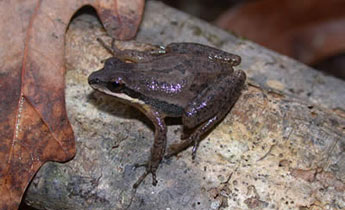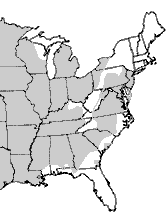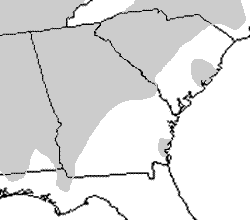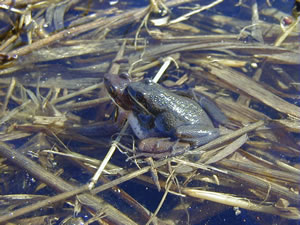Upland Chorus Frog (Pseudacris feriarum)



Photos by J.D. Willson unless otherwise noted
Upland Chorus Frog’s Call
Description: Upland Chorus frogs are small — 0.75-1.4 in (1.9-3.5 cm) — brown or grey frogs, with a light line across the upper lip and a dark lateral stripe running through the eye. Markings are highly variable. Generally, there are three longitudinal stripes down the back, but these may be absent or broken. Sometimes the dorsum appears streaked or spotted. Males can be distinguished by a vocal sac located under the chin. This species looks very similar to the Southern Chorus Frog, Pseudacris nigrita. The easiest way to distinguish the two species is by range (generally P. ferarium is found in the Piedmont and Mountains, while P. nigrita is found in the Coastal Plain) and by their calls.
Range and Habitat: Upland Chorus Frogs are found throughout the eastern US, but are primarily restricted to the Piedmont. Although this species is generally replaced by P. nigrita in the Coastal Plain, there are a few isolated
P. feriarum populations in the South Carolina Coastal Plain. They are found in grassy areas, woodlands, wetlands, and bogs. Habits: The upland chorus frog breeds from February to March. Adults congregate and call from
wetlands, ditches, and slow-moving creeks. Larvae take 2-3 months to complete metamorphosis. Tadpole diets include algae, diatoms, and decomposed plant material.
Call: The call of Chorus Frogs has been likened to the sound that a comb makes when a finger is run down the bristles. Pseudacris feriarum’s call is smooth and fast, whereas Pseudacris nigrita’s call is more prolonged and jerky.
Conservation Status: These frogs are considered common and are not protected in our region.
Pertinent Reference:
Britson, C.A. and R.E. Kissell. 1996. Effects of food type on developmental characteristics of anephemeral pond-breeding anuran, Pseudacris triseriata feriarum. Herpetologica 52:374-392.
Account: – J.D. Willson, Katrina Ford, Lauren Maynor

